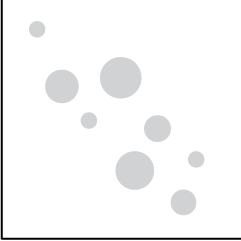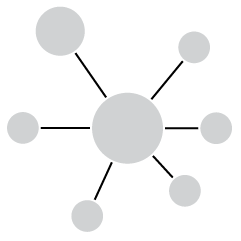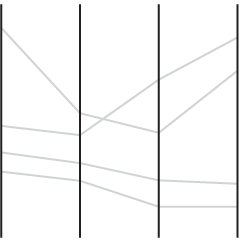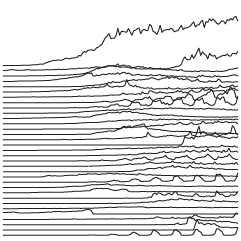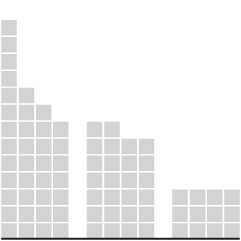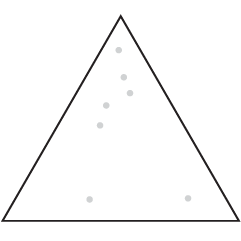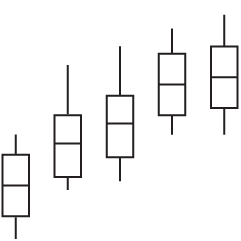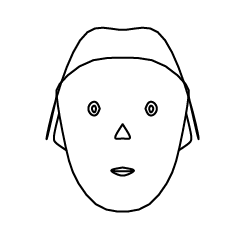This stream of consciousness video (below) from Current is complete with animated infographics and some lovely narration. I have no idea why the video was made or if there was a story behind where the video came from. However, I do know that the narrator’s voice is both reassuring and soothing, and I am ten times smarter after watching it.
Read More
-
-
I keep stumbling on rants about how media coverage of presidential candidates is uneven, biased, etc. Everymoment Now provides a way to see what’s going on with the election from the coverage (and sort of statistical) standpoint. From Craig, the developer of Everymoment:
In order to limit the scope I’ve decided to keep the focus (for now) on the 2008 US general election. It’s a timely, pertinent and, I believe, quite fascinating topic to study under this sort of data visualization lens. When all is said and done, you’ll be able to use this site to look back over the last 100 days leading up to the election and see how the shifts between candidates played out in the media. I think we all have a sense that things may get pretty nasty in the coming weeks. I feel that having a bird’s eye, hindsight view of how things went down, which stories the media focused on and how that ultimately influenced the final outcome will be an invaluable resource.
Check out spikes in coverage of the candidates or even events and locations. Lots of sparklines and lots of bar graphs very nicely organized.
Read More -
 Some of you might have noticed that FlowingData has a new sponsor in the sidebar. It’s Eye-Sys, an impressive visualization tool that aims to make complex data easy to understand. It serves a wide variety of data audiences with capabilities in traditional statistical visualization, GIS, and scientific visualization. Eye-Sys sports a drag and drop user interface that lets you hook visualization into data from both text files or databases. No need for programming. There’s a lot of cool stuff in their galleries, so I urge you check them out, if just to look at pretty pictures.
Some of you might have noticed that FlowingData has a new sponsor in the sidebar. It’s Eye-Sys, an impressive visualization tool that aims to make complex data easy to understand. It serves a wide variety of data audiences with capabilities in traditional statistical visualization, GIS, and scientific visualization. Eye-Sys sports a drag and drop user interface that lets you hook visualization into data from both text files or databases. No need for programming. There’s a lot of cool stuff in their galleries, so I urge you check them out, if just to look at pretty pictures.On another note, keep an eye out for another FlowingData contest in the near future. Thanks, Eye-Sys!
-
Like what you see here? Subscribe to the feed to stay updated on what’s new in data visualization.
In the not too distant past, the Web was all about sharing, broadcasting, and distribution. The tide is turning. The Web is moving towards the individual. Applications spring up every month that let people track, monitor, and analyze their habits and behaviors in hopes of gaining a better understanding about themselves and their surroundings.
We saw what data can be recorded in the personal visualization project. Some data lend themselves to easy tracking while others are easier to monitor with the aid of an application. These 23 tools, to track the minutiae of everyday life, try to fill that niche.
Is it information overflow or are we learning more about ourselves?
Read More -
There’s lots of free geographical data about what’s going on at the surface of our planet. It’s a different story for what going on underneath though. OneGeology aims to be the solution to that problem.
OneGeology is an international initiative of the geological surveys of the world and a flagship project of the ‘International Year of Planet Earth’. Its aim is to create dynamic geological map data of the world available via the web. This will create a focus for accessing geological information for everyone.
I’ve never been one for the geology, but if the data (and interactive maps) were easily accessible, there certainly would be a peak in interest.
[via msnbc | Thanks, Samantha]
-
Michael comments, “Onionmap is nothing when compared to this Chinese site…They’ve practically mapped out the entire Shanghai (and quite a few other China cities) in a SimCity-like fashion! Amazing stuff!” He’s completely right. Edushi maps Shanghai with great detail. While OnionMap looks like Google Maps with SimCity sprinkles, Edushi is just straight up SimCity.
Unfortunately my three years of Chinese classes in high school did me no good, and I don’t understand a thing on the site. Maybe someone can translate and let us know what Edushi is all about. Chinese CitySearch?
[Thanks, Michael]
-
Like what you see here? Subscribe to the feed to stay updated on what’s new in data visualization.
Last week was the end of our FlowingData personal visualization project. I asked readers to collect data about themselves or their surroundings and then visualize it some way. Thank you to everyone who participated. It put a smile on my face every time I got an email with “summer project” in the subject line :).
Read More -
Skyrails is an interactive graph visualization system that looks a lot like a video game. Explore relationships, visit nodes, and immerse yourself in the data. As I watch the demo video on YouTube, I feel like I’m seeing another world.
You’ve got the standard ball and stick view. Whether it’s useful for analysis or deeper understanding of relationships between whatever is up for debate, but one thing’s for sure – it looks cool. Plus the code is open source.
[Thanks, Atilla]
-
-
I was exchanging email with Rob a few days ago, and he brought up that I might see a slight boost in traffic from Australia because he had spread the word (thanks!) at a statistics conference. I immediately went over to Google Analytics, and indeed, there was an increase in traffic from the land down under.
Read More -
Mashups have been around for a while now, but for the most part have required at least a little bit of web development. Maybe it’s a line of javascript or thousands. Mozilla Labs, with the Ubiquity plugin, aims to make mashup-making accessible so that everyone can view data how they want everywhere on the Web. Use natural language like “map this” to stick a map into your email or get Craigslist offerings out of the list and onto a map.
For version 0.1, the application looks interesting. Check out the demo (or even install the plugin yourself):
[Thanks Colin and Jodi]
-
Nike+ is a device you hook up to your shoe and iPod Nano to track your running patterns and receive feedback while you’re running. Already a million people around the world have been training with the device, with the U.S. putting up 2.4 million global training miles. This past Sunday was “the day the world stopped to run” in the Nike+ Human Race 10K.
Read More -
Last month, FlowingData had a pretty good month moving up to rank 4,130 on Technorati and growing from about 4,000 subscribers to 4,500, so our community has grown a bit. Thank you to all of you who have been spreading the word!
In case you missed them, here are some of the best posts from August:
- Watch the Rise of Gasoline Retail Prices, 1993 – 2008
- It’s Like Google Maps with Sim City 2000 – OnionMap
- Map of Olympic Medals in Bubble + Geographic Form
- Britain From Above – Beautiful Use of Satellite Technology
- Visualize Genomes and Genomic Data – Circos
- Beginner’s Guide to FlowingData – A Guided Tour
- Is There a Market for Premium Online Data Visualization?
- Awesome Olympics Coverage By The New York Times
- Many Eyes Adds Wordle to its Extensive Visualization Toolbox
- 3 Worthwhile Alternatives to the Pie Chart
-
Stamen has taken a step towards the concrete with their recent Hurricane Tracker for MSNBC. From what I can tell, it updates every couple of hours or so. The tracker shows where Hurricane Gustav has been and where it’s headed and provides information on wind speed, ground speed, and location.
From the map we see a development from tropical depression in the Caribbean Sea, to a big category 4 over Pinar Del Rio, and then something between a category 3 and 2 as it moves over New Orleans. Gustav dwindles to a tropical storm as it moves towards Dallas. With mandatory evacuations of New Orleans starting yesterday, here’s to hoping everyone finds somewhere safe to stay.
-
Some will find this amusing while others won’t get it at all. If you don’t get it, consider yourself lucky. Have a good weekend, everyone.
[Thanks, Canna]
-
 I used to ride my bike to school, and I always forgot my U-lock. Instead of riding back for it, I’d just stash my bike unlocked in between a cluster of bikes. I told my friend jokingly, “It’ll be OK. 98% of people are good.” One day I got out of class, and my bike was stolen.
I used to ride my bike to school, and I always forgot my U-lock. Instead of riding back for it, I’d just stash my bike unlocked in between a cluster of bikes. I told my friend jokingly, “It’ll be OK. 98% of people are good.” One day I got out of class, and my bike was stolen.I was cleaning up some Actionscript in preparation for a tutorial post on how to make your own animated Walmart map, but a couple of bad memories involving stolen code and bad knockoffs (of my work) stopped me midway. I had to think:
Is releasing my code the best thing to do?
I’m sure the consensus is a resounding yes, but what’s to stop some lazy person from ripping off my code and pawning it off (or worse, selling it) as their own? What if I want to sell my visualizations? I am after all a lowly graduate student. It’d be nice to have another income stream.
On the other hand, had others before me not released their work under that wonderful BSD license, I would not be able to do what I do. At least not as easily. Modest Maps? Free. TweenFilterLite? Free. Flare Visualization Toolkit? Free. If I don’t follow suit, does that make me selfish? Yes, it does.
Giving Back to the Community
I’ve heard that phrase, giving back, so many times in both the real-life sense and the digital one, but it never made much sense to me. I mean, I got it, but I never really got it.
Perhaps I never understood it, because I wasn’t using much of the community’s resources nor did I have anything to give back. I have something to give back now. I can help people learn in the same way that others before me have and still do. I’m incredibly thankful to those who maintain these open source projects and still help me out from time to time when there’s really nothing in it for them.
The least I can do is continue to promote this idea of openness and help this small field of data visualization flourish into what it deserves to be. It’s why I blog, and it’s why I should give back, but to what extent?
Making the Case for Open Source Data Visualization
 My dilemma brought me back to a Data Evolution post on open source data visualization. It highlighted three things:
My dilemma brought me back to a Data Evolution post on open source data visualization. It highlighted three things:- Open Tools – As in freely available software tools like R and Processing.
- Open Code – How often have you seen a visualization and wondered, “How did they do that? If only the code were available.”
- Open Data – Oh so important in data visualization. The core. Open data means more people can try out different methods.
It’s not always possible to attain all three. For example, we pay money for software because the companies would not exist otherwise. It’s a business, and to think that software companies would develop a bunch of free software is unrealistic. Also, oftentimes, data just can’t be shared – usually because of privacy issues. Lastly, open code doesn’t make sense a lot of the time. The DE post grades The New York Times with a D for openness, but they’re a news business, not a visualization repository.
While we can’t always attain all of three things, there’s no reason why we can’t try to strive towards that ideal. As someone I know likes to say – strive for perfection. You might not reach that standard, but you could end up with something close.
Open source is a development method for software that harnesses the power of distributed peer review and transparency of process. The promise of open source is better quality, higher reliability, more flexibility, lower cost, and an end to predatory vendor lock-in.
Tweeting Thoughts
I of course tweeted this in the middle of the night while watching the day’s remaining olympic events – to release code or not to release code. Here are are some of the replies:
@rpj: To release, always! (When legally possible.)
@ehrenc: re: code. You could always release half the code :)
@pims to release code. There’s some brilliant people around that can build on top of what you did. Open world :)
As for me, well, let’s just say you should expect to see tutorials – complete with code – in the coming weeks.
-
Keep track of what’s getting reported about the presidential race in somewhat realtime with perspctv. It’s a nicely done news dasboard that updates on its own showing updates from CNN, Twitter, and the Blogosphere. It also shows poll results, predictions, daily reach, and search volume.
They’ve got charts (above); they’ve got maps:
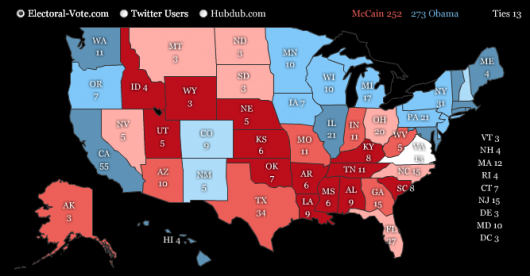
they’ve got timelines:

and they’ve got widgets:
In essence, it’s a news aggregater, but it’s a really good one and a great dashboard for you election junkies.
[Thanks, Iman]
-
As some commented on an earlier post, FusionCharts provides an easy way for people to hack together statistical graphics – sometimes not so attractively – and put the results on their websites. Widgenie serves as case in point. The concept of the application is all well and good. Upload some data and embed the “interactive” graphic on your blog, website, etc.
The realization of that idea however, needs some work. Aside from my difficulties logging on, changing my password, and non-flexible data upload, the widgets are, for the most part, just FusionCharts out of the box. Like the lollipop I made (below)?
[via ReadWriteWeb | Thanks, IA_chrissie]
-
I haven’t seen I.O.U.S.A. yet, but from the online bonus clips, it looks like it could be a good watch for you infographics junkies. The documentary examines the growing national debt and the consequences it will have on its citizens, so the source material sort of lends itself to plummeting time series charts with dramatic flare.
Here’s one showing personal savings rate over time:
Deficits and social security over time:
Debt-to-GDP projections:
A $53 Trillion Federal Financial Hole:
Those are just the bonus clips. I’m sure there are plenty more in the actual documentary.
[Thanks, @samkim]
-
A quick announcement – I just wanted to remind everyone (and point out to new readers) that there’s just one week left until the end of our summer project on personal visualization. I admittedly haven’t done a very good job of motivating all of you to this, but if you’d like a chance to win, submit by the end of September 1. Eternal glory is at stake.

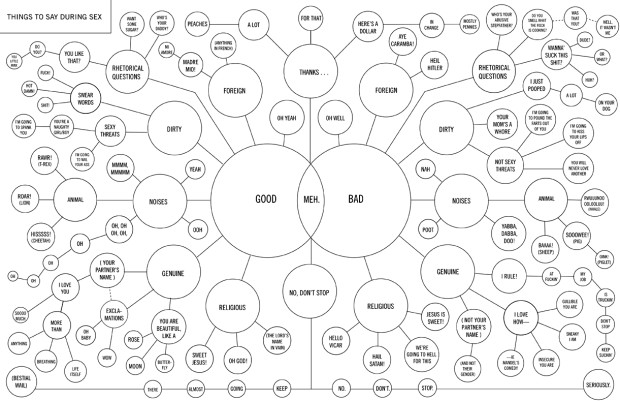
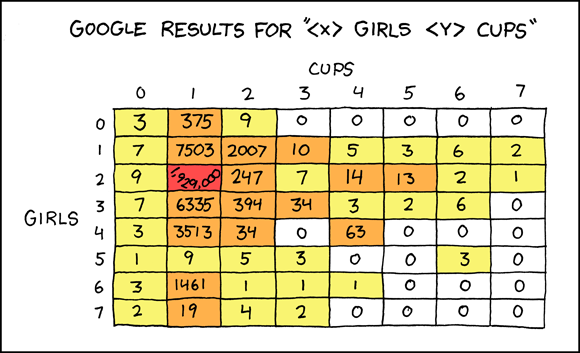
 Visualize This: The FlowingData Guide to Design, Visualization, and Statistics (2nd Edition)
Visualize This: The FlowingData Guide to Design, Visualization, and Statistics (2nd Edition)
